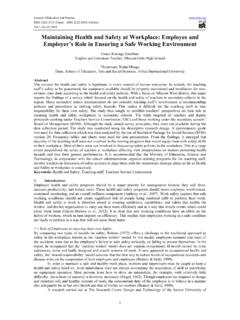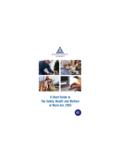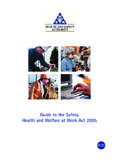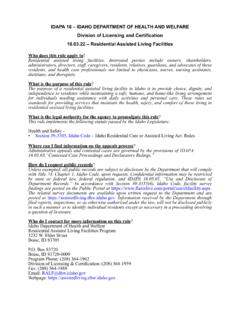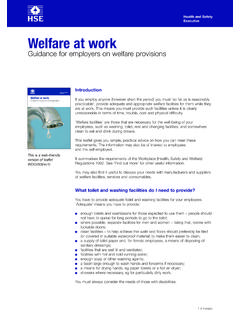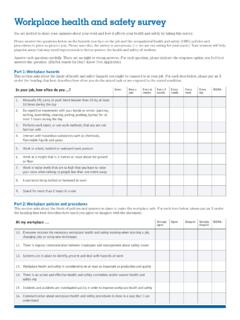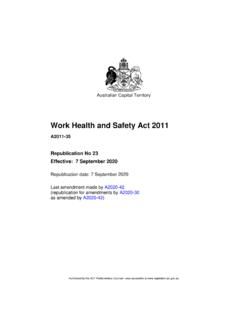Transcription of Health and Safety in the Salon
1 1 VTCT. 2016 Health and Safety in the Salon Beauty Therapy - Learner Manual 2 VTCT. 2016 Health and Safety in the Salon Aim The aim of this manual is to develop understanding of the principles of Health and Safety at work within a Salon , barbershop or spa. It will introduce the overarching legislation and explore the measures designed to protect the Health and Safety of people in the workplace, including staff, visitors and members of the public. It will also develop knowledge of how to recognize hazards and their associated risks along with the understanding of skills required to manage a safe and hygienic work environment that meets with the necessary regulations and legislation requirements. Learning outcomes By the end of this unit the learner will: Know the principles of Health and Safety Understand how to maintain Health , Safety , hygiene and security practices Understand how to follow emergency procedures 3 VTCT.
2 2016 Terminology Health A state of wellbeing Safety The absence of risks Workplace Any area or building where people work Health and Safety policy A document outlining an employer s policy and commitment to Health and Safety Health and Safety Executive (HSE) The body that regulates Health and Safety and enforces authority Accident An unplanned and uncontrolled event with the potential to cause injury Hazard Something that has the potential to cause harm Risk The likelihood that a hazard will cause harm Personal protective equipment (PPE) Specialist equipment or clothing to protect from harm against Safety hazards, gloves, goggles, protective apron welfare The provision of facilities and any other measures to ensure a person s wellbeing Appointed person A person with specific duties, for example relating to first aid but not necessarily a person who is trained in first aid Work related stress Feeling anxious, unwanted pressure that can cause harm to the mind and body and has strong links to absences from work 4 VTCT.
3 2016 Section 1: The principles of Health and Safety The importance of Health and Safety Health and Safety is important to keep people and safe and prevent them from harm! The main purpose of the various laws and legislation is to ensure Health , Safety and welfare of people is a priority! These laws apply to all working environments, including hair and beauty salons and to self-employed and mobile hairdressers and beauty therapists. Health and Safety law applies to everyone in the workplace employers, staff, customers and visitors or guests. Employers have responsibility to provide and maintain a safe working environment and welfare facilities. They are also responsible for developing policies and standard or normal operating procedures to guide safe practice. Employers must provide safe working systems Staff need to follow these procedures in all their daily activities.
4 They need to be inducted to Health and Safety requirements and receive other specialist training required for their work role, risk assessment, first aid, manual handling, safe use of chemicals. 5 VTCT. 2016 Customers, visitors and guests need to be informed of appropriate rules and behaviours to ensure they also take responsibility for their Safety , following instructions from signs provided, such as not walking across a wet floor where a sign has been displayed. Everyone has responsibility for maintaining Health and Safety . The main factors that influence Health and Safety in a hair and or beauty Salon include: Environmental factors conditions in the workplace and working area, for example the working temperature, ventilation and noise Occupational factors the potential risk of certain illnesses due to the services or treatments being offered, for example asthma from exposure to certain hairdressing or beauty products Human factors how people can contribute to accidents due to inappropriate or poor behaviour, carelessness, error or haste 6 VTCT.
5 2016 The legal and regulatory requirements for Health and Safety There are numerous guiding legislations for Health and Safety . The Health and Safety at Work Act (1974) The Health and Safety at Work Act (1974) was the main piece of legislation offering directives to maintain Health and Safety in England, Scotland and Wales. The Act was expanded, and in 1999, was replaced by the Management of Health and Safety at Work Regulations. 1999 The Health and Safety at Work Order 1978 (Northern Ireland) was the main piece of legislation for Northern Ireland. The Act was expanded, and in 2000, was superseded by the Management of Health and Safety at Work Regulations 2000 (Northern Ireland) Despite these developments, the main guiding principles of both the Health and Safety at Work Act (1974) and the Health and Safety at Work Order 1978 (Northern Ireland) continue The main guiding principles include: The Health , Safety and welfare of all people should be maintained at all times and all organisations should operate within policy guidelines.
6 Hazardous chemicals or substances should be handled and stored securely and risk of emission should be controlled. People should be protected against any risks that may occur as a result of activities in the workplace. The work place should provide clean and hygienic facilities, including the availability of drinking water, changing areas and toilets, first aid rooms in larger organisations Appropriate equipment should be provided for use and adequately maintained. The appointment of qualified staff to provide supervision and instruction (as appropriate) and the provision of additional training, as required, first aid and Health and Safety . Adequate insurance to cover accidents, employer and public liability The provision of reporting and recording mechanisms, accident books Regular review and evaluation of all healthy and Safety policies and procedures to ensure they are current, valid and reliable.
7 Employers and employees have direct responsibilities for Health and Safety and a duty of care to take reasonable and practicable steps to ensure that people are kept safe and free from harm. 7 VTCT. 2016 Employers must Employees must Provide and maintain safe working environment. Provide adequate welfare facilities. Provide safe systems of work. Provide information, training and supervision. Ensure the safe handling, storage and movement of goods and materials. Provide and maintain safe equipment. Act responsibly and not endanger self or others by an individual s actions. Co-operate with an employer to fulfil duties. Not misuse anything provided in the interests of Health and Safety . Report all accidents, incidents and unsafe conditions of practice. For example: For example: Providing a training session specifically dealing with the Salon s policies and reporting on sickness and general welfare , handling and storage of equipment Providing training sessions for hairdressing and/or beauty therapy to develop skills and product knowledge Providing a Salon uniform.
8 Providing training on professional conduct and how to greet clients and answer telephone calls Mandatory attendance at training sessions. Ensuring they present a professional image. Ensuring their conduct is professional and aligns with Salon guidance. Reporting verbally or in writing to manager, supervisor or Salon owner any accidents or incidents, however minor, that may occur All organisations employing more than five people are required to display a Health and Safety poster. Management of Health and Safety at Work Regulations. 1999 and Management of Health and Safety at Work Regulations 2000 (Northern Ireland) The 1999/2000 regulations emphasised the importance of risk assessment to ensure Safety . All staff, whether employed or self-employed have a responsibility to assess their working areas and assess any risk to themselves, their work colleagues and members of the public.
9 The Health and Safety Executive (HSE) provide five simple steps for assessing and managing risk 1. Identify the hazards (anything that may cause harm) 2. Determine who may be harmed 3. Evaluate the level of risk (likelihood and severity) and decide on precautions needed 4. Record all findings 5. Review and update regularly Further information on risk assessment is available from the HSE: 8 VTCT. 2016 Reporting of Injuries, Diseases and Dangerous Occurrences Regulations 1995 (RIDDOR) The RIDDOR regulations require that ALL injuries, diseases and dangerous events that happen in the workplace are recorded using the appropriate recording document and reported to the Health and Safety Executive (HSE). Work-related illnesses may include dermatitis or occupational asthma from the use of specific hair or beauty products.
10 The HSE are responsible for enforcing Safety regulations and investigate reported incidents and provide advice to organisations. Enforcement of regulations may include prosecution, if appropriate steps have not been taken. Employees must ensure that they have notified the employer of any potential work-related illness, injury or dangerous occurrence that occurs within the Salon in order that the employer can fulfil their reporting obligations Control of Substances Hazardous to Health Regulations 2002 (COSHH) The COSHH regulations require that appropriate assessment and precaution is taken to protect against harm from hazardous substances. In a Salon environment this may include: Chemicals, such as those used for cleaning and products used for hair colouring etc. Biological agents, such as bacteria in spa areas (Jacuzzis) or in laundry facilities (when sterilising equipment) Naturally occurring substances, such as dust or mould in damper, humid areas Jacuzzi, steam rooms or even the Salon itself It would also include substances produced during work activities, such as, fumes from mixing of chemicals or electrical filing of nails 9 VTCT.

